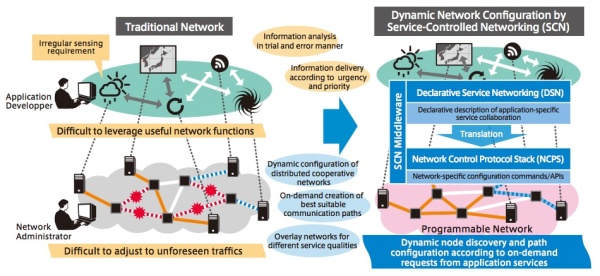Home > Network Research Headquarters > "Value Creation" Network Service Platform Project
Networks, during flexible transport of data abruptly generated beyond expectations or analysis of enormous amount of data through trial and error, are required to re-configure themselves according to the level of urgency or the importance of required information serv ices, so as to avoid an extraordinary increase of management or operation cost.
We develop new technologies for precisely and promptly delivering information service requests to networks and dynamically adjusting network configurations in order to process an enormous amount of data distributed in networks and efficiently collaborate different information services, on the basis of the high processing power and scalability of the New-Generation Network Infrastructure.
Specifically, we aim at the following:
1. Proposing information service-controlled networking
2. Building open test-beds for the collaborative development of applications with the composition of information services
3. Integrating the research outcomes into the New-Generation Network Infrastructure
In particular, the information service-controlled networking technology supports the functionalities of information service coordination embedded in networks and continuous service delivery. Our technology enables networks to handle unexpected, suddenly occurred information such as disaster mitigation information, analyze vast amounts of data by trial and error, and prioritize information delivery according to urgency or importance. In addition, it allows searching and providing alternative information services on the New-Generation Network Infrastructure.
We will contribute to the realization of the Future Networks(Recommendation ITU-T Y.3001)objectives, such as“ Data-Oriented” or“ Service-Oriented”, by implementing the information service-controlled networking. Networks will have capabilities to accept information service requests and to dynamically adjust their configuration in the New-Generation Network Infrastructure. Finally, we expect the future networks to be configured on demand for establishing ad-hoc and high-efficient communication paths between services and nodes, and logically segregating communication traffic according to service types or environments, even though certain situations happens such as natural disasters.







